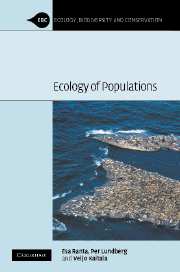Book contents
- Frontmatter
- Contents
- Preface
- 1 Introduction
- 2 Population renewal
- 3 Population dynamics in space – the first step
- 4 Synchronicity
- 5 Order–disorder in space and time
- 6 Structured populations
- 7 Biodiversity and community structure
- 8 Habitat loss
- 9 Population harvesting and management
- 10 Resource matching
- 11 Spatial games
- 12 Evolutionary population dynamics
- 13 Epilogue
- References
- Index
3 - Population dynamics in space – the first step
Published online by Cambridge University Press: 02 December 2009
- Frontmatter
- Contents
- Preface
- 1 Introduction
- 2 Population renewal
- 3 Population dynamics in space – the first step
- 4 Synchronicity
- 5 Order–disorder in space and time
- 6 Structured populations
- 7 Biodiversity and community structure
- 8 Habitat loss
- 9 Population harvesting and management
- 10 Resource matching
- 11 Spatial games
- 12 Evolutionary population dynamics
- 13 Epilogue
- References
- Index
Summary
The population renewal processes discussed in the previous chapter assumed spatially homogenous environments. For natural systems this mostly fails to be true. Here, we extend the population renewal in space and will hence come back to the problem of including emigration and immigration in population dynamics. We will do so by arbitrarily delimiting the landscape into well-defined habitat patches connected by redistribution of individuals. This simplified representation of spatial structure and population dynamics allows us to analyze and interpret a wide range of single-species phenomena. Spatial structure can alter the population dynamics significantly and produce emergent phenomena such as synchrony and complex dynamics. This chapter sets the theoretical and conceptual stage for such problems dealt with in more detail in the coming chapters.
In the previous chapter, we deliberately overlooked the important and natural aspect of the import and export of individuals to and from a given focal population. For some populations, ignoring dispersal may be a fair approximation. Most extreme examples of this might be experimental populations of fruitflies in a single container or small aquatic microcosms of protozoans. In such cases, it would be natural to assume that a complete mixing occurs in the whole population. Most populations, however, are spatially structured and the exchange of individuals between landscape elements is an integral part of the dynamics (Hastings 1990; Kareiva 1990; Bascompte and Solé 1997; Tilman and Kareiva 1997).
- Type
- Chapter
- Information
- Ecology of Populations , pp. 39 - 65Publisher: Cambridge University PressPrint publication year: 2005



